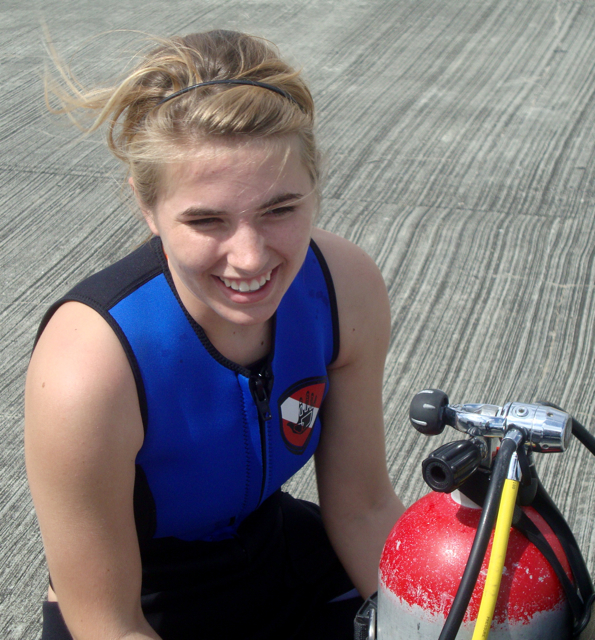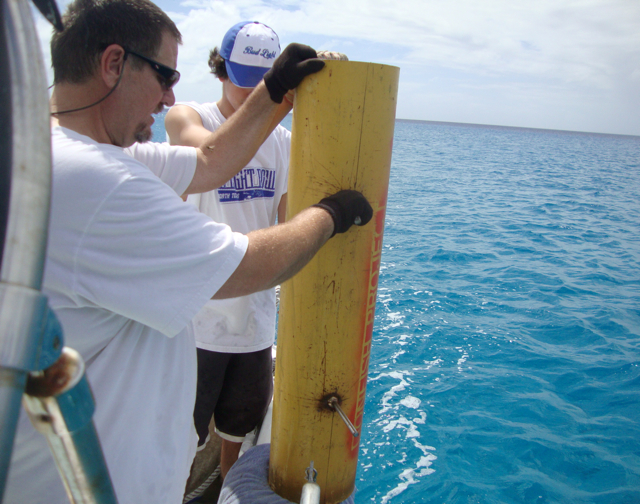
One such step took place Monday when a team of volunteers joined Coles and MacKenzie MacQueen, a senior at the Good Hope School, to lay a series of traps around the Frederiksted Pier. The traps are part of MacQueen’s project for the school’s science fair, but more importantly, they’re part of an island-wide effort to slow down the marauding fish.
Coles used the Super Bowl as a reference point to put the fish’s growth in perspective.
"Super Bowl Sunday in 2009, we caught the second lionfish in St. Croix waters," he said. "The next year, Super Bowl Sunday 2010, we caught 17."
A week ago, on Super Bowl Sunday 2011, Coles said "thousands" of the fish were caught. One local diver says he has caught and killed more than 14,000 of the fish himself.
With no natural enemies, a defense mechanism of poison spines, and a hunger that just won’t quit, lionfish can take over an area and wipe out the indigenous fish species that make their homes in the territory’s coral reefs.
At first swimmers, divers and fishermen don’t notice much, as the predators dine on the small, newly hatched fish, scarfing down as much as 85 percent of the hatchlings in the first year.
But in a few years, perhaps as few as five, the reefs are swept clean. Those young fish that should have been refilling the piscine population have been wiped out, and the orderly process of life and death has been wrenched out of shape forever.
The lionfish is so prolific that local officials aren’t even talking about eradicating the interlopers any more. Now they talk about controlling them in an uneasy balance that allows the indigenous fish to hang on in the face of their voracious foes.

MacQueen is a certified diver, so the science fair project was a natural fit for her. But though it’s her project, local dive shops, businesses and government agencies have all taken a hand.
"All these people came together to help, because we know we’ve got to do something," said Neil MacQueen, MacKenzie’s father.
The traps were long steel tubes – actually old, steel air tanks used to refill scuba tanks. The tanks had been donated by dive shops. Hovensa cut both ends off the tanks, creating a tube, and welded steel rods projecting out of the middle of the tanks. The rods are to keep the tubes from rolling in the tide so that they’ll still be in the same place each time MacQueen goes down to check them and "harvest" her find.
On a dive boat volunteered by St. Croix Ultimate Blue Water Adventures – SCUBA – the team maneuvered around the pier, dropping a dozen traps along the edge of the trench that had been dredged out for cruise ships. After all the tubes were dropped, the divers went down to make sure they are set exactly where they want them. The air charges for the dive was donated by N2 The Blue dive shop.
Coles said the underwater remains of the old pier adjacent to the trench creates the kind of conditions where lionfish thrive.
Lionfish like small, enclosed places where they can hide, Coles said, and they don’t object to manmade homes. In fact, that might be how they first got into the local waters, hitching a ride with ships. If MacQueen’s project succeeds, the lionfish will take up residence in the tubes. Each time she goes down to the traps, she’ll secure a bag to one end of the tube, then use what is essentially a piston on the other side to push the fish into the bags.
MacQueen’s is far from the only effort being tried. Coles said he is collecting the gonads of female lionfish in the hopes that they can be ground up and used as an attractant to lure male fish to a place where they can be caught. Not only would it be good to get as many fish out of the water as possible, but removing a large number of males might slow down their reproductive cycle, he said.
A working group representing various agencies and individuals who are involved in different aspects of the struggle with lionfish has come together to combine their efforts, each adding their part, whether it’s research, education, finding government funding—or actually getting into the water and finding them.
Because in the end, that’s the most important part, Coles said. MacQueen agreed.
"We’ve got to get them out of the water," she said.